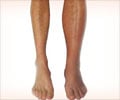Want to prevent blood clots? Then, start walking a mile for just 15 minutes every day to keep Deep Venous Thrombosis (DVT) at bay.

Cine actress Laxmi Manchu and CMD of the KIMS group of hospitals, Dr. B. Bhaskar Rao attended the walk held at Necklace road.
‘Walking for at least 15 minutes a day can save your life from getting Deep Venous Thrombosis (DVT).’
Read More..




Read More..
Advertisement
Are Blood Clots a Life-threatening Medical Condition?
Addressing the occasion, Dr. Narendranadh Meda, HOD and Senior Consultant Vascular & Endovascular Surgeon, and Foot Care Specialist at KIMS Hospitals spoke on the occasion, said: "Acute venous thromboembolism (VTE), including deep venous thrombosis (DVT) and pulmonary embolism (PE), is the most common preventable cause of hospital death, and a source of substantial long-term morbidity. The incidence of DVT is increasing in the general population as well, because of sedentary lifestyles, and unhealthy habituations among the general public.Advertisement
When is Deep Vein Thrombosis Awareness Month?
He pointed out that internationally, March is observed as DVT awareness month. DVT refers to a blood clot or thrombus that forms in one or more veins deep inside a person's body. It usually develops in the leg. It blocks blood circulation. The clots can break off and travel through the bloodstream, and thus become fatal."Some symptoms are swelling, pain, discoloration, and abnormally hot skin in the affected area. In most DVT cases, these symptoms are not seen, the treatment gets delayed and it causes death. DVT is most accurately diagnosed through D dimer assessment along with venous ultrasound and venography. People with prior DVT, stroke, pregnancy, obesity, undergoing major surgery, over the age of 65, and those confined to long periods of immobility such as travel or bed rest are more at risk for deep-vein thrombosis than others," the doctor said.
Advertisement
Men or Women: Who’s at Risk for Deep Vein Thrombosis?
Laxmi Manchu noted that women have more chances to get DVT. Specifically, estrogen hormonal therapy and hormonal birth control can raise a person's chances of developing DVT. From puberty to menopause, women bear the highest risk of venous thromboembolism. Even after menopause years, women have a high chance of getting VTE and DVT. Pregnant women and women taking birth control medicines are at risk of DVT."I suggest women be more cautious. Walk a mile a day, and it can reduce the risk a lot. Women walk more for daily chores at home. But, seriously walking for 15 minutes a day can relieve us from getting this deadly problem called DVT," she said.
Symptoms of Deep Vein Thrombosis (DVT)
"Swelling in one leg, pain, heating of the affected area, reddishness, hard sensation of nerves are some of the symptoms of DVT. It can happen not only in the legs but also in the hands, abdomen, and other areas too. Some may feel breathlessness, and chest pain as well. Those who are 60 plus of age, obese, smokers, and people who suffered from cancer, heart attacks, and varicose veins will have more chances to get DVT. Those who travel for more than 3 hours either by Car, Train, or Flight also have risk. It can come even if one doesn't have any of these. Daily walking, raising the affected leg while sitting, avoiding flight journeys for two or three weeks while using anticoagulants is always better," said Dr. Bollineni Bhaskar Rao.Source-IANS















